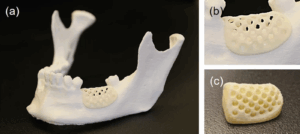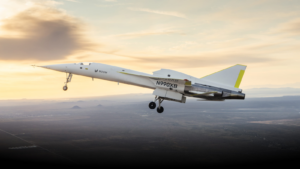SpaceX’s Starship vehicle reaches orbit for the first time
The world just got one step closer to traveling to Mars. On March 14, 2024, SpaceX conducted the third flight test, Integrated Flight Test-3 (IFT-3), of its Starship rocket, the world’s largest and most powerful. The rocket lifted off from the company’s Boca Chica facilities in Texas, sending the 397-foot (121-meter) vehicle into the sky. This mission was the third test flight of Starship and was much more successful than the previous two (1).
Starship is comprised of two stages, the bottom being a booster named Super Heavy and the top being the Starship spacecraft. Super Heavy is propelled by 33 SpaceX Raptor engines, providing up to 7,590 ton-forces of thrust. The upper stage, Starship, carries the payload. SpaceX plans for Starship to carry up to 100 people eventually. The Starship spacecraft has six Raptor engines, three of which are optimized for operating in the vacuum of space, where conditions require different engine designs than those used within Earth’s atmosphere (2).
Starship is designed to be fully reusable, which SpaceX plans to achieve by catching the Super Heavy booster with arms on its takeoff tower and landing the Starship spacecraft similar to its Falcon 9 rocket boosters. SpaceX hopes Starship will eventually be able to serve as a mode of transport between points on Earth and even beyond. One of SpaceX’s goals is flights to Mars, which it plans to achieve by using tankers to refill Starship in Earth’s orbit before continuing its journey (2).
IFT-1 and IFT-2, the two tests before IFT-3, happened in April and November of 2023, respectively, and both ended before they could carry out their mission objectives. During IFT-1, the two stages failed to separate, so SpaceX intentionally detonated the rocket. During IFT-2, the two stages successfully separated, but the mission ended prematurely eight minutes after takeoff due to a fire caused while venting excess oxygen (3, 4).
With data gathered from the previous test flights, SpaceX made numerous improvements to Starship, including spraying water over the launch pad during liftoff to reduce vibrations and “hot staging,” which starts firing the rockets of the Starship spacecraft before the two stages have fully separated in order to improve separation. Starship saw much more success during the IFT-3 mission, lasting 50 minutes and reaching many milestones (1).
During IFT-3, all 33 Raptor engines lit up and completed a full ascent burn. The hot-stage separation successfully lit up the engines on the upper stage and separated Starship from the Super Heavy booster. The Super Heavy booster then flipped around and completed a burn, sending it back toward Earth. Super Heavy was able to light several engines for its first-ever landing burn (5). However, not all of the engines that SpaceX was expecting to light up did, causing the vehicle to experience a “rapid unscheduled disassembly” (it blew up) approximately 462 meters above the ocean (1, 5).
In orbit, Starship’s second stage continued into space (5). The upper stage did not go into a full orbit but instead entered a suborbital coast around Earth to test two Starship flight systems needed for certification: reignition of the Raptor engines and transfer of cryogenic fuel between tanks (1). The vehicle successfully opened its payload door and transferred 10 metric tons of liquid oxygen between two tanks but was not able to relight its Raptor engines due to the vehicle rolling heavily while coasting (5, 6). During reentry, Starship continued to broadcast a live view of the vehicle as a plasma cloud formed around it (5). Typically, spacecraft experience a communication blackout as the re-entry plasma blocks radio waves, but SpaceX was able to utilize its Starlink satellite network to provide a continuous broadcast, giving unprecedented views of plasma during reentry (5, 7).
Shortly after, SpaceX lost contact with the vehicle when it broke apart while reentering the atmosphere (1). However, the flight provided valuable data for the development of Starship, including the first-ever data about the vehicle during reentry (5).
SpaceX has accelerated production of Starship vehicles, with the 4th test of Starship planned for early May, pending FAA approval. The Super Heavy booster has already been moved to the launch pad in preparation for the flight. The goal of the fourth test is for both the upper stage and Super Heavy booster to return back to Earth. For IFT-4, the Super Heavy will aim to land on a “virtual tower,” an imaginary target imitating a launch tower the booster would land on once operational, in the Gulf of Mexico. If successful, IFT-5 will aim to land on its actual launch tower. SpaceX founder and CEO Elon Musk said he was optimistic that they would be able to land the booster this year and the Starship vehicle next year (8).
SpaceX is also building new towers, one at its facility in Texas and one in Florida, which will allow testing to continue in case a tower is damaged accidentally. The company also hopes to start testing ship-to-ship propellant transfer next year, a crucial component of missions to Mars. Once fully operational, Starship will launch from NASA’s Kennedy Space Center in Cape Canaveral (D).
This accelerated production will help hasten progress on Starship. The craft is needed for NASA’s Artemis 3 mission, where it will be used as the lunar lander to send humans back to the Moon by 2026. This timeline gives SpaceX less than two years to complete Starship and get the vehicle certified. The company has also sold private trips around the moon on Starship and will rely on Starship to deploy its new generation of Starlink satellites into space (1). Furthermore, engine improvements are planned to increase the individual thrust of each engine from 230 to 280 tons-force and eventually to 330 (8).
If Starship development continues to go well, humanity will soon find themselves back on the Moon and beyond. We may eventually become a multi-planetary species. Next stop, Mars!
Citations
- Dinner, J. (2024, March 14). SpaceX launches giant Starship rocket into space on epic 3rd test flight (video). Space.com; Space. Retrieved from https://www.space.com/spacex-starship-third-test-flight-launch.
- SpaceX. (2024). SpaceX. SpaceX. Retrieved from https://www.spacex.com/vehicles/starship/.
- Wall, M. (2024, April 4). SpaceX moves Super Heavy booster to pad ahead of 4th Starship flight (photos). Space.com; Space. Retrieved from https://www.space.com/spacex-moves-starship-super-heavy-pad-testing-fourth-flight-photos.
- Foust, J. (2024, January 14). SpaceX says propellant venting caused loss of second Starship. SpaceNews. Retrieved from https://spacenews.com/spacex-says-propellant-venting-caused-loss-of-second-starship/.
- SpaceX. (2024, March 14). Starship’s Third Flight Test. SpaceX. Retrieved from https://www.spacex.com/launches/mission/?missionId=starship-flight-3.
- Petras, G., Borresen, J., & Beard, S. J. (2024, March 14). Did Starship land? How SpaceX’s third launch got lost over Indian Ocean. USA TODAY; USA TODAY. Retrieved from https://www.usatoday.com/story/graphics/2024/03/14/spacex-starship-launch-3-explained/72968637007/.
- McFall-Johnsen, M. (2024, March 14). SpaceX’s Starship reentry video after launch shows red-hot plasma. Business Insider; Insider. Retrieved from https://www.businessinsider.com/spacex-starship-reentry-video-2024-3.
- Foust, J. (2024, April 6). Musk outlines plans to increase Starship launch rate and performance. SpaceNews. Retrieved from https://spacenews.com/musk-outlines-plans-to-increase-starship-launch-rate-and-performance/.
Images




















Comments are closed.